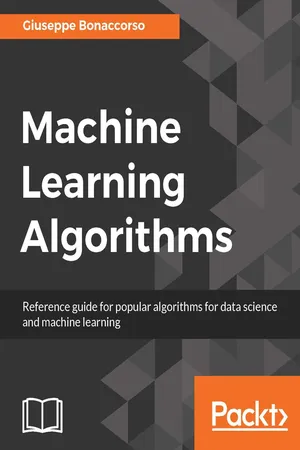
Machine Learning Algorithms
Giuseppe Bonaccorso
- 360 pages
- English
- ePUB (mobile friendly)
- Available on iOS & Android
Machine Learning Algorithms
Giuseppe Bonaccorso
About This Book
Build strong foundation for entering the world of Machine Learning and data science with the help of this comprehensive guideAbout This Book• Get started in the field of Machine Learning with the help of this solid, concept-rich, yet highly practical guide.• Your one-stop solution for everything that matters in mastering the whats and whys of Machine Learning algorithms and their implementation.• Get a solid foundation for your entry into Machine Learning by strengthening your roots (algorithms) with this comprehensive guide.Who This Book Is ForThis book is for IT professionals who want to enter the field of data science and are very new to Machine Learning. Familiarity with languages such as R and Python will be invaluable here.What You Will Learn• Acquaint yourself with important elements of Machine Learning• Understand the feature selection and feature engineering process• Assess performance and error trade-offs for Linear Regression• Build a data model and understand how it works by using different types of algorithm• Learn to tune the parameters of Support Vector machines• Implement clusters to a dataset• Explore the concept of Natural Processing Language and Recommendation Systems• Create a ML architecture from scratch.In DetailAs the amount of data continues to grow at an almost incomprehensible rate, being able to understand and process data is becoming a key differentiator for competitive organizations. Machine learning applications are everywhere, from self-driving cars, spam detection, document search, and trading strategies, to speech recognition. This makes machine learning well-suited to the present-day era of Big Data and Data Science. The main challenge is how to transform data into actionable knowledge.In this book you will learn all the important Machine Learning algorithms that are commonly used in the field of data science. These algorithms can be used for supervised as well as unsupervised learning, reinforcement learning, and semi-supervised learning. A few famous algorithms that are covered in this book are Linear regression, Logistic Regression, SVM, Naive Bayes, K-Means, Random Forest, TensorFlow, and Feature engineering. In this book you will also learn how these algorithms work and their practical implementation to resolve your problems. This book will also introduce you to the Natural Processing Language and Recommendation systems, which help you run multiple algorithms simultaneously.On completion of the book you will have mastered selecting Machine Learning algorithms for clustering, classification, or regression based on for your problem.Style and approachAn easy-to-follow, step-by-step guide that will help you get to grips with real -world applications of Algorithms for Machine Learning.
Frequently asked questions
Information
Topic Modeling and Sentiment Analysis in NLP
Topic modeling

Latent semantic analysis






from nltk.corpus import brown
>>> sentences = brown.sents(categories=['news'])[0:500]
>>> corpus = []
>>> for s in sentences:
>>> corpus.append(' '.join(s))
from sklearn.feature_extraction.text import TfidfVectorizer
>>> vectorizer = TfidfVectorizer(strip_accents='unicode', stop_words='english', norm='l2', sublinear_tf=True)
>>> Xc = vectorizer.fit_transform(corpus).todense()
from scipy.linalg import svd
>>> U, s, V = svd(Xc, full_matrices=False)
import numpy as np
>>> rank = 2
>>> Uk = U[:, 0:rank]
>>> sk = np.diag(s)[0:rank, 0:rank]
>>> Vk = V[0:rank, :]